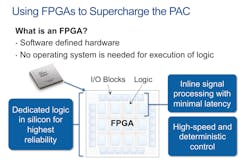Understanding the Appeal of Configurable PACs
While programmable logic controllers (PLCs) continue to be a mainstay of manufacturing automation applications, the trend toward greater use of more functional, PC-like programmable automation controllers (PACs) is clear. In particular, PACs are gaining broader acceptance in the industrial control market for applications that require highly integrated analog and digital I/O, floating-point processing, and seamless connectivity to multiple processing nodes.
Another attraction point for PACs stems from their use of field programmable gate arrays, which enables them to offer a high level of programmability.
National Instruments, for example, offers several PAC products whose FPGAs are programmable via the company’s LabView software development environment. Using development environments like LabView, users can define the logic embedded in FPGA chips without having to know low-level hardware description languages or board-level hardware design details. This means users who are not experienced with VHDL or other low-level design tools can define hardware for ultra high-speed control, customized timing and synchronization, low-level signal processing, and custom I/O with analog, digital, and counters within a single device.
“You also can integrate image acquisition and analysis, motion control, and industrial protocols, such as CAN and RS232, to rapidly prototype and implement a complete PAC system,” says Brian Phillippi, product marketing engineer for National Instruments’ CompactRIO.
“This level of programming is possible because an FPGA is a chip that consists of many unconfigured logic gates,” says Phillippi. “Unlike the fixed, vendor-defined functionality of an ASIC (application-specific integrated circuit) chip, you can configure and reconfigure the logic on FPGAs for your specific application.” (To learn more, watch the FPGA Powered PAC video featuring Brian Phillipi.)
Another way to understand the appeal of configurable PAC's is to look at data collection aspect of a PAC. In older scenarios a PLC would do the control and an HMI would handle the visualization and data logging. With Advantech's PAC solutions integrators can leverage the power of the open architecture and provide data storage along with control. Whether you need a store & forward solution for remote data collection or local data collection the PAC solution provides a platform. One aspect data collection becomes important is in predictive maintenance. This allows for integrators to increase the amount of data to be analyzed in predictions. "Using our .NET library, integrators can easily reference our I/O without having to know low level programming," says Kevin Romer, Application Engineer, Advantech.
About the Author
David Greenfield, editor in chief
Editor in Chief

Leaders relevant to this article:
